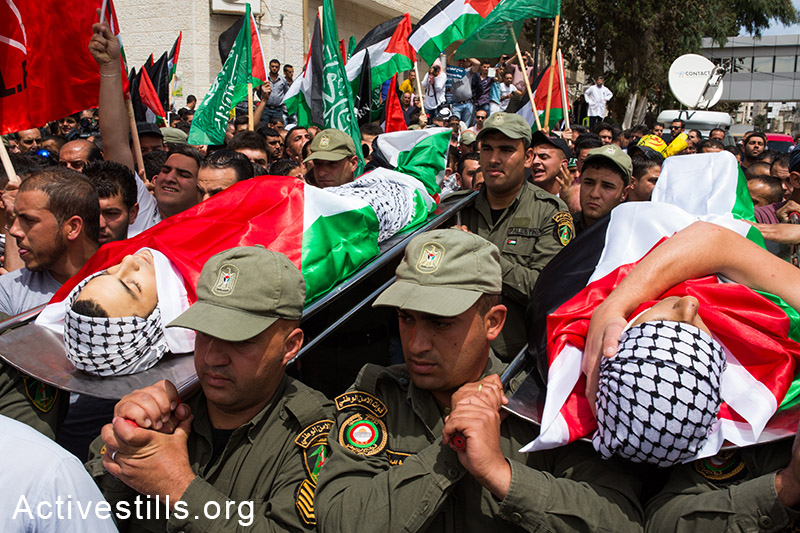The raging debate about the death of the Beitunia teens will become eternally self-referential as each side pumps up its own greater narratives. Herein lies perhaps the greatest victory for the stronger side.
Two Palestinian teens were killed last Thursday, Nakba Day. Until yesterday, it was also true that the Palestinian teens were shot with live ammunition by Israeli forces. There is excessive documentation – eyewitnesses, news outlets, still photos and 12 hours of video from the security cameras monitoring the shack-like structures where they were shot, owned by a private Palestinian.

A week later, the IDF embraced different facts. It is conducting an investigation and here are the theories that have come out so far, according to news reports: the IDF used only rubber bullets, not live ammunition. It is not clear that Israeli forces did it; the youth might have been shot by Palestinian fire. The youth who were brought to the hospital and died might not be the same youth who were shot. The 12 hours of video that shows them being hit, says an unnamed “senior security figure” to Haaretz, is “very likely fabricated.”
WATCH: Footage shows Israeli army’s killing of two Palestinian teens
These competing theories are like the opening shots (so to speak) in a race of narratives and obsession with angles. What was the direction of the shot? What could the soldiers see from their angle? Is a hospital report saying they were killed by live bullets credible? Should the graves be opened and a body exhumed, as the father of one of the dead has offered, to prove the truth?
There is something deeply disturbing about seeing these lines reappear almost verbatim as they have been spoken about previous incidents: in the case of Jawaher Abu Rahma, who died at a demonstration in Bil’in in 2011 after inhaling tear gas; or the towering symbol of Mohammed Al-Dura, the Palestinian child killed in crossfire during the Second Intifada, a symbol of martyrdom and manipulation to Palestinians and Israelis, respectively.
Why do public voices start playing with the truth? Mostly when they feel the truth will reflect badly on them. What does it means to manipulate the truth? Public figures are well aware that the post-modern mindset makes it hard to pin down facts. Throwing out theories, no matter how wild, raises doubts even if far-fetched. Using words inaccurately, or not admitting to one’s actions is another form. Accusing the other side of full-out conspiracy and elaborate fabrications is another.
In a recent article about Ukraine, The New York Times pointed out that facts are spun into fuses to light the fires for each side. Russian propaganda cries ‘fascist anti-Semites’ at Kiev, while Kiev calls pro-Russian separatists ‘terrorists.’ While I think the Times piece paints a naïve dichotomy between ‘healthy’ societies (like the US) and conflict situations, this line rings true:
The fragmentation of consensus about critical events and the degradation of legitimate political authority are like two apocalyptic horsemen riding together.
The apocalypse is solipsistic: the raging debate about the Beitunia teens, like Abu Rahma and Al-Dura, will become eternally self-referential as each side pumps up its own greater narratives. The IDF will continue to argue that the tape is fabricated, to frantically salvage its degraded political authority. It will become an example of Israeli righteousness and manipulative Palestinian wrongfulness and the whole community of blind-support for Israel will rally to this cause. Palestinians and supporters will continue to insist that unarmed victims are being murdered but nobody believes them or cares. That camp too will rally to its narrative.
Here lies perhaps the greatest victory for the stronger side. When the events move from hard facts to a battle of narratives, false symmetry emerges. My word against your word; my accusations of falsification and cover ups, versus yours. But the only thing false is the parity.
The Palestinians are a stateless people living under military occupation or as refugees. This situation began in 1948, which is why there are demonstrations that day – to protest the ongoing impossibility of their lives. Two Palestinian teens were shot and killed on 15 May, 2014 – that is a fact. The Nakba takes lives, physically and spiritually, to this day – that is its meaning.
Related:
WATCH: Footage shows Israeli army’s killing of two Palestinian teens
Beitunia killings and the media’s incredibly high bar for Palestinian stories
Human rights NGO: Investigate senior IDF officers over Ofer killings

